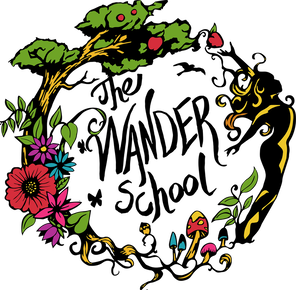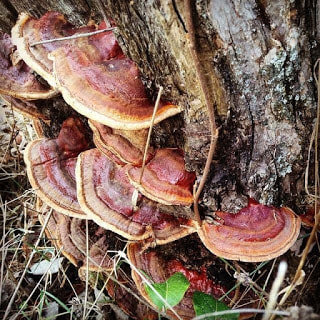|
Reishi, also known as the mushroom of immortality, is believed to be one of the most medicinal mushrooms ever known. (I'm about to whip out some Latin, so I apologize to non-science nerds. You can just ignore it, if you want.) There are multiple different species in the United States. They grow mainly around the northeastern US on dying hardwood trees such as oak, elm, maple, beech, and hemlock. Ganoderma lucidum is the species mostly commonly utilized in Traditional Chinese Medicine. Ganoderma means something like, "bright skin," lucidum, "shining." In the Appalachian mountains of North Carolina, where I live, Ganoderma tsugae is the most common species, because it grows on dying hemlock trees (Tsuga canadensis, not to be confused with poison hemlock, Conium maculatum, in the carrot family). Unfortunately we have a lot of dying hemlock here, due to damage from the non-native insect the wooly adelgid. The past couple of years, I've found another species, Ganoderma sessile, growing on maple trees, when I've visited Ohio. Sessile means, "stalkless". There are other species, as well, and debate on how similar they are genetically, whether some may be the same species or not. Full of vibrant and healing energy, reishi is a very powerful ally. It is one of the most important adaptogen herbs in chinese medicine. It has been utilized for anxiety, high blood pressure, hepatitis, bronchitis, Alzheimer's, insomnia, and asthma. Some of its most famous benefits, are that it has been considered anti-carcinogenic (anti-cancer), immune boosting, life extending, and stimulating to brain neurons. Reishi is commonly taken by tincture, an alcoholic extraction, or by tea.
How to make reishi tea or stock: Some people believe it takes a long time, 12 - 24 hours, to extract the constituents (medicinal components). If you harvest your own reishi, cut them into long, thin pieces before dehydrating. They're extremely tough and hard to cut once dry. They're dry once they break cleanly in half. You can break them into smaller pieces and grind them in a coffee grinder or leave in small chunks, and cover with at least twice as much water. (You can add veggies and herbs, if making a stock, or other roots, if you want to make a tea blend.) Bring to a boil, turn heat on low, and let simmer for around two to twenty-four hours. The longer you simmer, the more water you need. Strain out reishi pieces and enjoy! Some of y'all who know me well, know I'm a traditional Herbalist, so I'm not always big on exact measurements. If you want more details, check out this reishi article from my friends at No Taste Like Home. If you make your own tea or stock, let me know (in the comments) how it goes and if you create any fabulous new recipes of your own. If you don't want to make your own, check out my reishi tincture on my Etsy site. Co-written with Savannah Smith, previous intern. A republished blog just in time for reishi season.
4 Comments
|
Want to help us continue to do this important work |




 RSS Feed
RSS Feed